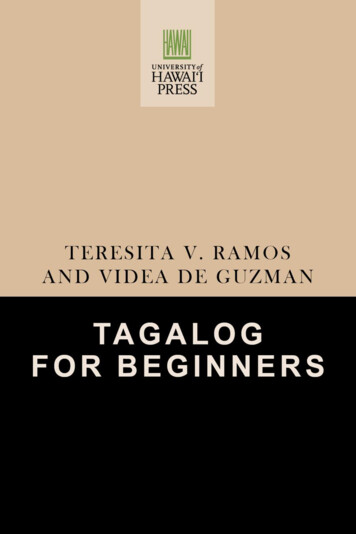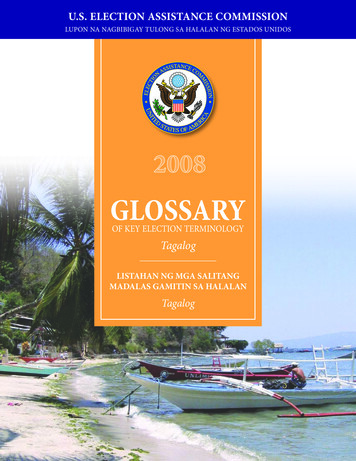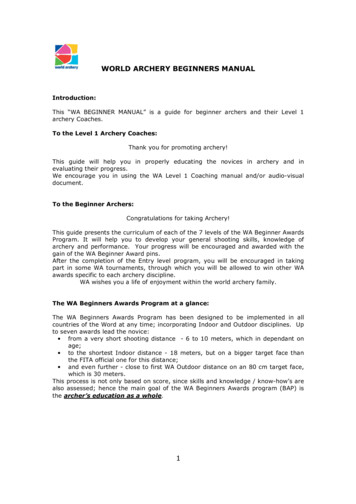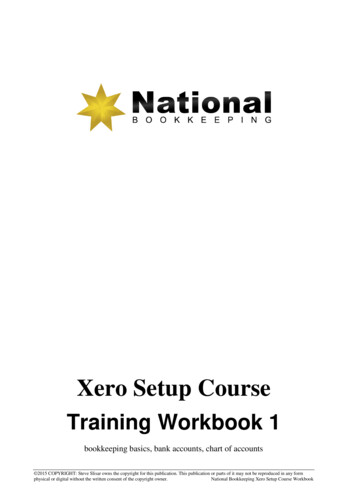
Transcription
Tagalog for Beginners
PALILANGUAGE TEXTS: PHILIPPINESSocial Science Research InstituteUniversity of HawaiiHoward P. McKaughanEditorii
TAGALOGFOR BEGINNERSTERESITA V. RAMOSVIDEA DE GUZMANUniversity of Hawaii PressHonolulu
Open Access edition funded by the NationalEndowment for the Humanities / Andrew W.Mellon Foundation Humanities Open BookProgram.Licensed under the terms of Creative CommonsAttribution-NonCommercial-ShareAlike 4.0 International (CC BY-NC-SA 4.0), which permits readers to freelydownload and share the work in print or electronic format fornon-commercial purposes, so long as credit is given to theauthor. The license also permits readers to create and share derivatives of the work, so long as such derivatives are sharedunder the same terms of this license. Commercial uses tps://creativecommons.org/licenses/by-nc-sa/4.0/. The Creative Commons license described above does not apply to anymaterial that is separately copyrighted.Open Access ISBNs:9780824882198 (PDF)9780824882181 (EPUB)This version created: 20 May, 2019Please visit www.hawaiiopen.org for more Open Access worksfrom University of Hawai‘i Press.The work reported herein was performed pursuant to a contractwith the Peace Corps, Washington, D.C. 20525. The opinions expressed herein are those of the author and should not be construed as representing the opinions or policies of any agency ofthe United States government.
Copyright 1971 by University of Hawaii PressAll rights reserved
PREFACEThese lessons in Tagalog for beginners form part of a serieswhich includes a Synopsis of Tagalog Structures and a TagalogDictionary both by Teresita V. Ramos. All three works have beendeveloped under a contract with the Peace Corps (PC25–1507)at the university of Hawaii through the Pacific and Asian Linguistics Institute. Similar materials have been developed underthe same contract for Bikol, Cebuano, Hiligaynon, Ilokano, Kapampangan and Pangasinan.The editor of the series and the author of these materialsare encouraged to believe that many are interested in learningTagalog. These materials should prove helpful to that end.Howard P. McKaughanEditorvii
ACKNOWLEDGMENTSTagalog for Beginners was made possible through the Pacific and Asian Linguistics Institute of the University of Hawaii,under the direction of Dr. Howard P. McKaughan by supportfrom Peace Corps, Washington, D.C. Special acknowledgmentsare due Richard McGinn, for editorial suggestions; RositaGallega, for helping in the initial writing of the text; BelenOngteco, for reviewing and helping proofread the materials; theTagalog staff of Peace Corps Philippines XXII, XXIII, and XXVII,for writing some of the supplementary materials, for trying outthe materials, and for giving suggestions on its improvements;and Peace Corps Hilo, for testing the tentative drafts during thetraining of Peace Corps Volunteers.viii
iiiThe Tagalog languagexiiiThe TextxviiiNotes to the teacherxxviSymbols Used in the TextxlixI. BASIC SENTENCE PATTERNS AND THEANG-CONSTRUCTION11. Greetings (po’); naman in responses32. More on greetings; ang-demonstratives: ito/iyan/iyon;question word ano ang- demonstratives123. Making introductions (po’); si personal proper noun;ang-pronouns: ako/ka/siya; question word sino ang-pronoun234. Question word sino si / ang ; ang-pronouns:tayo/kami/kayo/sila; question word sinu-sino and pluralpersonal proper noun marker sina; review: questionword ano ang-pronoun315. Review: ang-pronouns and si/sina markers; ba questionmarker; oo/hindi responses; positive and negativestatements416. More on affirmative and negative responses; ikaw; moreequational sentences; alternate marker o; particles nga’and lang; tag question hindi ba507. Introduction of the um-verbs; introduction of theng-pronouns: ko/mo/niya; review: greetings,introductions, leave-takings, and other courteousexpressions608. Question words taga-saan and saan; sa location;may/wala constructions69 699. Question word ano (-ng) time expression; kailan; timeexpressions: araw/buwan/petsa; numeral marker: a-/ika79II. THE NG-CONSTRUCTIONix87
CONTENTS10. Review: question word ano; ng-pronouns: ko, mo/ninyo,niya; noun phrase marker ng; personal proper nounmarker ni8911. Review: ng-pronouns: ko/mo/niya; ang-demonstratives:ito/iyan/iyon; ng-phrases in expanded topic9512. Question word ilan; counting system; review: questionword ano with parts of the body10313. Sentence inversion with the particle ay; review:negative statements and questions11114. Ng-demonstratives: nito/niyan/niyon or noon; review:ng-phrases; question words ilan and ano; ay12015. Question words alin and kanino; ng-pronounsnatin/namin/ninyo/nila; review: singular form ofng-pronouns12816. Request form paki-; introduction of the in-verbs;commands in the negative form with huwag13617. Introduction of the mag- and ma-verbs; the negativemarker huwag with mag- and ma-verbs14518. Gusto/ayaw ng-phrase -um-/mag-/ma-verb15119. Gusto/ayaw ng-phrase in-verb ang-phrase;introduction of the i-verb15920. Gusto/ayaw ng-phrase ng-phrase166III. EXISTENTIAL CONSTRUCTIONS17321. Mayroon/wala’ -ng noun/pronoun -ng noun;negative questions with wala’17522. May noun ang-phrase; may/mayroon/wala’ locative phrase (time expression)18323. Ano with time expression; review: may/mayroon/wala’;may/mayroon/wala’ with particles na and pa19124. Adjectives with and without ma-; adjectives attributiveto nouns; particles na and pa, nga’ and pero naman,and lang with adjectives19825. Adjectives attributive to verbs20826. Tagalog numbers; simple mathematical operations ofaddition and subtraction215IV. ASPECTS OF VERBS IN ACTOR-FOCUS22327. Completed aspect of the um-verbs22528. Contemplated aspect of the um-verbs; conjunction kasi23229. Incompleted aspect of the um-verbs; conjunction nang24330. Completed aspect of the mag- and ma-verbs250x
CONTENTS31. Contemplated aspect of the mag- and ma-verbs32. Incompleted aspect of the mag- and ma-verbs;prepositions bago and pagkatapos infinitive formthe verb33. Review of the three aspects of the um-, mag-, andma-verbsV. ASPECTS OF VERBS IN GOAL-FOCUS34. Competed aspect of the in-verbs35. Contemplated aspect of the in-verbs36. Incompleted aspect of the in-verbs37. Aspects of the i- and an-verbs in goal-focus258of266272281283290295302VI. THE SA-CONSTRUCTION AND THE OTHERFOCUSES31138. Review: sa-phrases, may/mayroon/wala’;sa-demonstratives: dito/diyan/doon31339. Sa-pronouns: sa amin/sa atin/sa inyo/sa kanila/saakin/sa iyo/sa kaniya; personal proper noun markerkay/kina; review: saan and kanino32340. Nasa-phrases; nasa-pronouns; personal proper nounmarker na kay/na kina33141. Review: nasaan; nasa-demonstratives:nandito/nandiyan/nandoon34242. Locative-focus verbs in three aspects34743. Para sa-phrases; para sa-pronouns; personal propernoun marker para kay/para kina; review: kanino35344. Benefactive-focus verbs in three spects359VII. RECENTLY COMPLETED ASPECT AND SOMEMODALS36745. Recently completed aspect; review: na, lang36946. Modals maaari’, puwede, dapat and kailangan; review:na and pa37647. Pseudo-verbs alam and ibig38548. Request form maki- (actor-focus)392VIII. EXPANSION OF STRUCTURES39749. Review: adjectives and linkers; comparative sentences:mas/higit (kaysa/sa noun/pronoun) / (kay personal proper noun), magkasing/kasing, pinaka-;pluralization of adjectives39950. Numerals and quantifiers; question words magkano,ilan and gaano414xi
CONTENTS51. More on noun modification; review: na-linker,nasa-phrases; introduction of naka- and taga52. More expanded structures using conjunctions: at,nang, dahil/kasi, kung and kaya’IX. APTATIVE AND CAUSATIVE VERBS53.54.55.56.425442451Maka-, makapag- and ma- aptative affixes453Causative actor-focus affix magpa-; review: para460Causative goal-focus affix ipa467Non-causative actor-focus affix pa- -in and papag- -in473Appendix I Classified Supplementary Vocabulary ListsAppendix II Expressions for Various OccasionsAppendix III Pronunciation DrillsAppendix IV Charts Showing Verbal Aspect FormationsAppendix V Worksheets for Informant SessionsAppendix VI Sample Oral and Written TestsAppendix VII Native SongsGLOSSARYxii479535569588598618636645
INTRODUCTIONTHE TAGALOG LANGUAGEThe Philippines is made up of a group of islands off thesoutheastern coast of Mainland China. There are about 80 to150 different languages in the Philippines which belong to theMalayo-Polynesian family. Tagalog, the principal languagespoken in the large northern island of Luzon, is one of the eightmajor languages. It is spoken by approximately fifty percent ofthe population either as the mother tongue or as the linguafranca.Tagalog was chosen as the basis for Pilipino the Philippinenational language in 1937. Recently, ‘Pilipino’ has been replacing English as the medium of instruction in the Philippineschools. It is spoken in Manila, the largest city in the Philippines, and is often used as the language of communication insocial and political gatherings even in non-Tagalog provinces.There is also an abundant literature in Tagalog which is increasing rapidly.Tagalog has been influenced by Sanskrit, Chinese, Spanish,and English. A number of borrowings from these languageshave become a part of current usage. Tagalog is still borrowingmany terms from English.Tagalog is spoken as the mother tongue in the followingprovinces: Bataan, Batangas, Bulacan, Cavite, Laguna,Marinduque, Nueva Ecija, Occidental Mindoro, OrientalMindoro, Quezon, and Rizal.Some of the features of the Tagalog language not present inEnglish follow.Sound system1. Initial p-, t-, k-occur unaspirated in Tagalog. In Englishthese sounds occur with aspiration, as in pit, tip, and kit. Whenoccurring after sibilants, however, they are unaspirated, as inspit, stand, and skin. The English speaking student must becareful not to heavily aspirate the voiceless stops in Tagalogwords.xiii
INTRODUCTION2. As in English, Tagalog has a velar nasal spelled withtwo letters. This sound is indicated by the digraph ng and ispronounced as in English sing. However, this sound appearsalso initially in Tagalog words and in that position will give theEnglish speaking student some trouble—for example: ngiping‘tooth’, ngunit ‘but’, and ngayon ‘now, then’.3. The glottal stop in Tagalog sounds like the stop betweenthe two “o’s” of English ‘Oh, oh’. This sound is very importantin Tagalog because it distinguishes some words from others.For example, note the following: bata’ ‘child’ vs. bata ‘robe’,basa’ ‘wet’ vs. basa ‘read’, baso’ ‘try, explore’ vs. baso ‘drinkingglass’, apo’ ‘sir, ma’am’ vs. apo ‘grandchild’.4. English has many more vowel sounds than Tagalog. TheTagalog vowels are written a, e, i, o, and u. The student iscautioned to imitate the Tagalog sounds carefully, since theyare quite similar to English sounds, but must be pronouncedwithout diphthongization.Word formation1. Most words are made up of affixes and roots. The rootsare substantive, verbal and adjectival in meaning, and the affixes indicate such things as aspect, focus, and mode. The specific meaning of a word is determined by the particular combination of the root and its affix.For example, the root aral ‘study’ may denote the followingvariations in meaning depending on the affix added.magaral (v.)mangaral (v.)makaaral (v.)makiaral (v.)palaaral (adj.)pagaaral (n.)aralan (n.)to studyto preachto be able to studyto join someone in studyingalways studyingstudyingplace for studying2. Reduplication is used extensively in word formation to indicate noncompleted action, intensity, plurality, restriction, etc.kainkakaineatwill eatxiv
INTRODUCTIONkumainkumakainto eatis eatingmagandamagagandabeautifulbeautiful (plural)isaisa isaiisaiisaisaoneone by oneone onlythe only one (intensified)3. Almost any Tagalog root may be verbalized. Note the following.ayaw (adv.)umayawnegative particleto refusebato (n.)mambatostoneto throw stonesdamit (n.)magdamitdressto dresspagod (adj.)mapagodtiredto become tiredmalaki (adj.)magmalakibig, tallto be proudbigla’ (adv.)mabiglasuddenlyto be surprisedBorrowed words which are nouns can also be verbalized:basketballcutexmag ‘basketbol’magpa ‘kyutiks’to play basketballto have a manicureSentence construction1. The normal order of Tagalog simple sentences is the predicate or Comment followed by the subject or Topic. In Englishthe order is reversed. The fillers of the predicate or commentxv
INTRODUCTIONare verbal or nonverbal in both languages. However, in Tagalogthe nonverbal comments include prepositional phrases as wellas adverbial words as illustrated in the following.Verbal n)Natulog(Slept)Nagluto(Cooked)ang bata.(the child)ang tao.(the man)ang babae.(the woman)Maganda(beautiful)Sa bayan(in town)Bukas(tomorrow)Nars(nurse)ang bulaklak.(the flower)ang prosisyon.(the procession)ang laro’.(the game)ako.(I)Nonverbal CommentsAdjectivalPrepositionalAdverbialNominal2. In Tagalog there is no equivalent of the copulative verbto be. The meaning of the copular is denoted by the juxtaposition of the Nonverbal Comment and the Topic, as seen in theexamples above.3. One of the most important features of Tagalog is calledfocus. Focus is the grammatical relation between the verb and aparticular verbal complement marked by ang. This complementis referred to as the Topic of the sentence. The semantic relationship of the Topic to the verb (actor, goal, benefactor, etc.) isindicated by the verbal affix.Focus may, therefore, be viewed as referring to voice. InEnglish there are the active and the passive voices. The activevoice indicates that the actor of the action is the subject of thesentence. The passive voice indicates that the object or goal ofthe action is the subject. In Tagalog voice may be equated toFocus and the subject to Topic. Hence, the active voice is theactor focus with the actor of the action as topic, and the passivevoice is the goal focus with the object of the action as the topic.xvi
INTRODUCTIONIn addition to the actor and the goal focuses, there are thelocative, the benefactive, and the instrumental in Tagalog. Inthe locative the location of the action is the topic; in the benefactive the benefactor or recipient of the action is the topic; inthe instrumental the instrument with which the action is performed is the topic.In English we can say ‘The child bought bread from the storefor his mother,’ or we can say ‘The bread was bought by thechild from the store for his mother.’ In Tagalog, the followingare possible. The topic of the sentence in each case is introduced by ang and is underlined. The corresponding translationof the Tagalog topic is underlined in the English sentence forconvenience (but not for emphasis).Focus/Topic Verbal AffixSentencesActor/Doerum-Bumili ang bata ng tinapay satindahan para sa nanay niya (sapamamagitan ng pera ng tatay niya).‘The child bought bread from thestore for his mother (by means of hisfather’s money).’Goal/Object-inBinili ng bata ang tinapay satindahan para sa nanay niya (sapamamagitan ng pera ng tatay niya).‘The child bought bread from thestore for his mother (by means of hisfather’s money).’Locative/Location-anBinilhan ng bata ng tinapay angtindahan para sa nanay niya (sapamamagitan ng pera ng tatay niya).‘The child bought bread from thestore for his mother (by means of hisfather’s money).’i-Ibinili ng bata ng tinapay sa tindahanang nanay niya (sa pamamagitan ngpera ng tatay niya).‘The child bought bread from thestore for his mother (by means of hisfather’s money).’Benefactive/Beneficiaryxvii
li ng bata ang pera ng tatayniya ng tinapay sa tindahan para sananay niya.‘The child bought bread from thestore for his mother by means of hisfather’s money.’Topic in Tagalog, therefore, is not limited to the doer or theobject of the action, but may also apply to the location, the beneficiary or the instrument of the action.4. Another distinctive feature of Tagalog is the extensive useof linkers (or ligatures) to connect words, phrases, and sentences signifying the relation of modifier and modified. Theyoccur, for example, between adjective or numeral and noun,verb and adverb, and noun or verb and dependent clause. Thereare two forms of the major linker, -ng and na. The first occursfollowing words that end with a vowel and the second followswords that end with a consonant. Examples follow:magandang dalagaisang bata’mabuting magtrabahodalagang nagreyna sa bayanmalalim na dagatbeautiful girlone childto work wellthe girl who became town queendeep seaThe Modifier and Modified may also occur in reversed orderwith the exception of numeral and dependent clause modifiers,in which cases the former is always preposed and the latterpostposed to the modified. Therefore, dalagang maganda andmagtrabahong mabuti may occur but not *bata’ na isa or *nagreyna sa bayan na dalaga.THE TEXTTagalog for Beginners is an elementary textbook which hasbeen prepared for Peace Corps Volunteers going to the Philippines for their tour of duty. The material contained within itsnine units is designed to be covered in about 280 – 300 hours ofclassroom instruction.xviii
INTRODUCTIONThis text was inspired by the ‘micro-wave’ format developedby Dr. Earl Stevick, Foreign Service Institute, Department ofState.Objectives of the TextThe goal of the Text is to teach the Volunteers how to communicate effectively in Tagalog, that is, to be able to speak thelanguage with sufficient structural accuracy and vocabulary tosatisfy the normal social and work requirements in the hostcountry.To attain this goal of self-expression in Tagalog, the Text hasbeen designed to give the student the following.1. A mastery of the basic structures of the language and amanipulation of these patterns leading towards meaningful andeffective communication.2. A mastery of a reasonable amount of functional vocabulary plus a supplement of vocabulary needed for incountry jobassignments.3. The ability to hear and reproduce the new language witha minimum of interference.4. An understanding of how the language works and theability to make generalizations.5. The ability to form and understand novel utterancesbased on an internalized grammar of Tagalog.Language learning is best accomplished by the attainmentof the aims mentioned above plus the knowledge of the generalcultural context or situation in which the language is used.Organization of the TextThe whole text is organized around units consisting of fourto eleven lessons each, making a total of 56 lessons. Each lessonconsists of one to five cycles totalling 142 cycles. Each unitdeals with major grammatical constructions: Basic SentencePatterns and the Ang-Construction; the Ng-Construction; Existential Constructions; Aspects of Verbs in Actor-Focus; Aspectsof Verbs in Goal-Focus; the Sa-Construction and Other Focuses;Recently Completed Aspect and Some Modals; Expansion ofxix
INTRODUCTIONStructures; and Aptative and Causative Verbs. The progressionof structures is from simple to complex to help the languagelearning process.How to use the TextIn general, each lesson consists of a series of cycles, variousdrills, a cumulative dialogue or series of short dialogues, a vocabulary list, and grammar notes. Occasionally, cultural notesare added to the lesson. In some units, reading and writing exercises are introduced to reinforce mastery of earlier lessons.The procedure followed throughout the text uses the auraloral method. All lessons are introduced orally at a normal rateof speed by the instructor. The students are made to listen carefully to distinguish critical sounds and words from the start andto reproduce them accurately.Format of each lessonLessons in each unit are presented in the following format.Lesson #(The grammatical content of the lesson)Cycle # (Title of the Cycle)M1(The first line of a two line dialogue, usually thequestion)M2(The response to M1)C(The combination of M1 and M2 which is amicro-exchange or a cycle)Types of drills1.2.3.4.5.6.Identification drillRepetition drillSubstitution drillMoving-slot drillSubstitution-replacement drillTransformation drillxx
INTRODUCTION7.8.9.10.11.12.13.Expansion drillCued-response drillChain drillQuestion and answer drillComprehension drillCompletion drillSituational drillCumulative Dialogue (or Dialogues)Reading and Writing Exercises (in some lessons)The micro-wave formatBasically, the micro-wave format is a text consisting of aseries of cycles. Each of these cycles, which is the core ofthe lesson, is usually a very brief exchange of a question andan answer—the answer generally illustrating the grammaticalpoint or pattern being taught. Each cycle is marked by anumber and has two phases: an M-phase and a C-phase.In the M-phase, the students mimic the instructor’s pronunciation until he is satisfied; they learn the meaning of each sentence, and they memorize the sentences. Then they manipulatethe new sentences they have learned, either in drills given inthe text or in ways which the teacher may require. For example,after some basic patterns such as question, negative, and imperative patterns have been learned, the teacher may want students to transform any new sentence pattern learned into yes/no questions, imperatives and negatives, whether or not thatdrill is specifically called for by a given cycle. Mimicry andmemorization in the M-phase can best be done with the students’ books closed. They can, however, check the meaningswith books open.In the C-phase, each section of which is a very short conversation, the students use what they have learned and practicedin the M-phase to communicate in real situations. The C-phaseof the cycle is communicative in the sense that it always refersto real persons, objects, and events, not to abstract or imaginary concepts.The M-phase is usually presented in a question and answerformat. In this text, to approximate the actual sequence of utterance occurrence in real life conversations, the first M-sectionxxi
INTRODUCTIONis a question followed by the second M-section which is a possible answer to the question presented. In some other texts thatuse the micro-wave format, the sequence is reversed.The combination of an M1 and an M2 is a communicationsituation indicated by C. There are as many communication situations as there are combinations of M1 and M2.Example (An excerpt from Lesson 10)Cycle #1: Asking for one’s name.M1 Ano ang pangalan ko? What is my name?Ano ang pangalan mo/ What is your (singular,ninyo?informal)/(singular, formal) name?Ano ang pangalanWhat is his/her name?niya?M2 Mrs. Cruz (po) angpangalan ninyo.Ben (po) angpangalan ko.Juan (po) angpangalan niya.Mrs. Cruz is your (singular, formal)name.Ben is my name.John is his/her name.Procedure for the M-phase1. The sentences above are repeated after the instructor.One important goal is good to excellent pronunciation.2. The instructor then gives a cue—say a proper name, andthe students (and later individual students) give the whole sentence. This is the manipulative part of the cycle.3. Next, the question is taught by the instructor. The abovemay follow the question if deemed desirable by the instructor.4. Meaning may be given before or after the manipulativephase.The possible combinations of M1 and M2 leading to the communication situation or the C-phase are as follows:C1 Ano ang pangalan ko?Mrs. Cruz (po) ang pangalan ninyo.C2 Ano ang pangalan mo?xxii
INTRODUCTIONBen (po) ang pangalan ko.C3 Ano (po) ang pangalan ninyo?Mrs. Cruz ang pangalan ko.C4 Ano ang pangalan niya?Juan (po) ang pangalan niya.Procedure for the C-phase1. The instructor takes the part of the first speaker in theconversation and has students take turns as the second speaker.2. The instructor has the students take both parts in the conversation.3. Instructor or students may Introduce extra vocabulary if(a) the new words are of special relevance to the interests of thestudents; and (b) the new words fit into the substitutable partsof the C-phase.In the C-phase, the fictitious names are replaced by theactual names of the members of the class so that genuine communication takes place. This results in a chain drill which is actually more of a conversation than a drill.A chain drill may develop from a simple response type to amore complex one where the student first responds to a conversation initiated by another and then initiates the conversationhimself with a different student.The teacher initiates the drill by directing questions to astudent who answers and continues the series of conversationsby asking the student next to him the same questions theteacher asked him. This continues until the question is finallydirected to the teacher thus marking the end of the chain drill.ExampleT Ano angpangalan mo?Ano angpangalan niya?S1 Juan po ang pangalan ko.Ric po ang pangalan niya. (Directing thequestion to S2)Ano ang pangalan mo?S2 Maria, ang pangalan ko.S1 Ano ang pangalan niya?xxiii
INTRODUCTIONS2 Ben ang pangalan niya. (Directing thequestion to S3) etc.This ends the cycle. A competent instructor will present acycle of this kind in 30 minutes.Cycles can be independent of each other since each containsadequate material for at least one dialogue. They are sequencedgrammatically from easy to difficult.At the end of about twenty such cycles, the students shouldbe able to participate in a longer dialogue which combinesseveral of these two line conversations. The teacher shouldwork toward this combination of cycles to enable the student,after 200 – 300 hours of classroom instruction, to do the following in Tagalog comfortably: to order a simple meal, ask for aroom in a hotel, tell time, ask and give street directions, hagglein the market, handle travel requirements, and engage in casualconversations about work, family, and self.The cycles alone, however, cannot lead to extended conversations. They are too brief and choppy if merely strung together.To bridge this naturalness gap, each lesson is supplementedby a cumulative dialogue(s), which is an integration of thenew cycle or cycles taught with relevant cycles previously presented.Supplementary drills and dialoguesThe cycles are used to present the grammatical structuresmeaningfully, but beyond this, the more conventional audiolingual techniques are used. Since the cycles cannot handle extended conversations in a given social situation, various drillsand small cumulative dialogues have been added to the material. These drills are arranged from simple to expanded sentence drills. The cumulative dialogues integrate relevantlearned cycles with the new ones. They are, however, not asrigidly controlled as the cycles. The cumulative dialogues are asnatural as possible. They are made to approximate real life conversations.Such supplementation allows introduction of material whicha micro-wave format cannot handle adequately. It also providesthe students with a change of pace and a variety of activities,and should provide a better text than one strictly following themicro-wave approach or the audio-lingual approach.xxiv
INTRODUCTIONVocabulary listEach lesson has its own vocabulary list of new words in addition to a cumulative glossary at the end of the language materials.The list has two columns: Tagalog first followed by theEnglish gloss. The Tagalog words are arranged alphabetically(following the English system) for easy reference. The glossary,however, uses the Tagalog alphabetical system i.e., k after b andng after n.Verb roots are separated from their affixes which are hyphenated and enclosed in parentheses, for example, (nag-su-)suklay, ‘combing’.The linker -ng is separated from the base or root by ahyphen and enclosed in parentheses.Grammar notesFollowing the vocabulary list there are grammar notes forthe student. The notes discuss at least each structural pointpresented in the lesson and supply examples from the text forverificational purposes. These notes should not be read nordiscussed during language class hours. They should be readoutside of class and tried out by students creating sentencesand having the instructors check their constructions. Thesegrammar notes can be discussed with a language coordinatorduring grammar sessions.Cultural notesRelevant, cultural notes are inserted to give an understanding of certain values, concepts or practices mentionedin the cumulative dialogues. Some of the cultural aspects discussed are the use of the respect particle po’; the practices ofgiving a ‘blow out’, ‘haggling’; greeting people; the local systemof measurement; native delicacies like balut, durian, etc.AppendicesSeven appendices to supplement the lessons in the Textcontain the following materials: Appendix I - classified supplementary vocabulary lists; Appendix II - useful expressions forvarious occasions; Appendix III - pronunciation drills; Appendixxxv
INTRODUCTIONIV - four charts showing verbal aspect formations; Appendix V- worksheets for informant sessions; Appendix VI - sample oraland written tests; Appendix VII - native songs.Each appendix is prefaced by a short description of what itscontents are, how it should be used, and what its purposes are.NOTES TO THE TEACHERDrills provide a great part of the pedagogical core of thetext. Therefore, the teacher may want a detailed exposition ofthe types of drills given in the text and how to go about teachingeach type. It is absolutely essential to understand the scope andpurpose of the drills in order to be able to teach the material effectively.However, learning to manipulate sentences alone is notenough to achieve the goal of self-expression in Tagalog. Thestudents must be led gradually to learn the skill of making thesesentences and others like them to fit into specific situations thatthey meet in training and others that they will
CONTENTS PREFACE vii ACKNOWLEDGMENTS viii INTRODUCTION xiii The Tagalog language xiii The Text xviii Notes to the teacher xxvi Symbols










